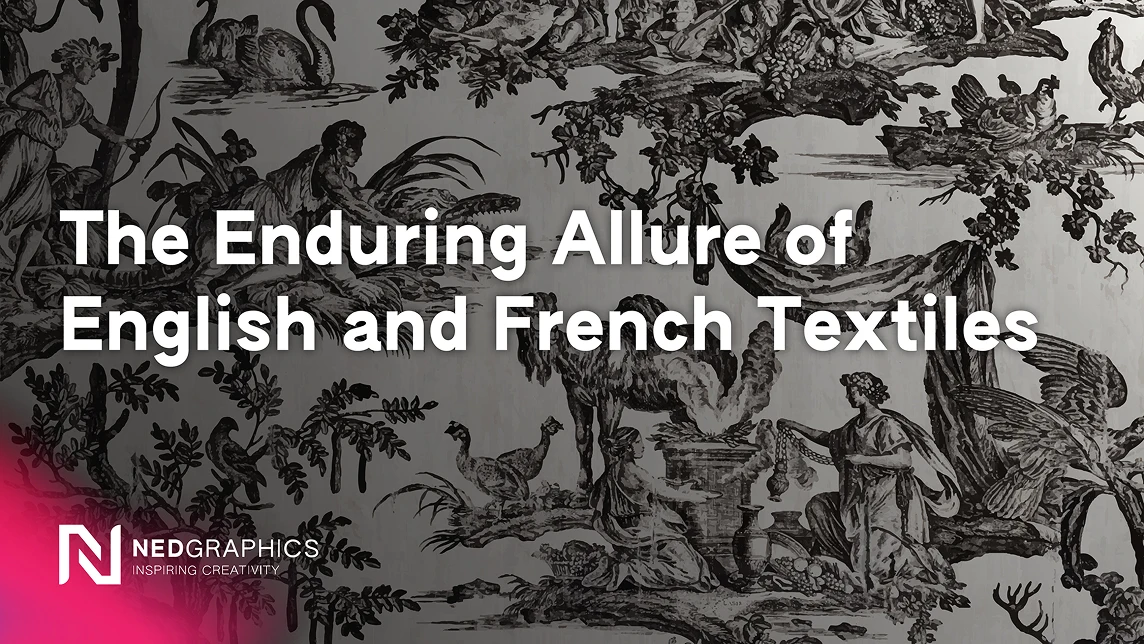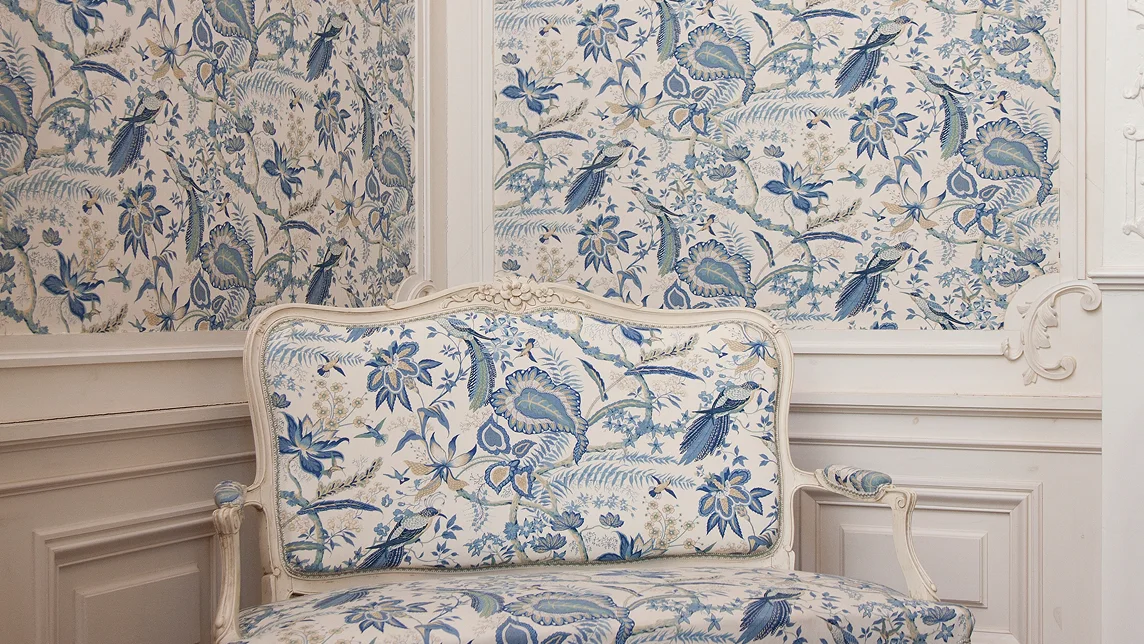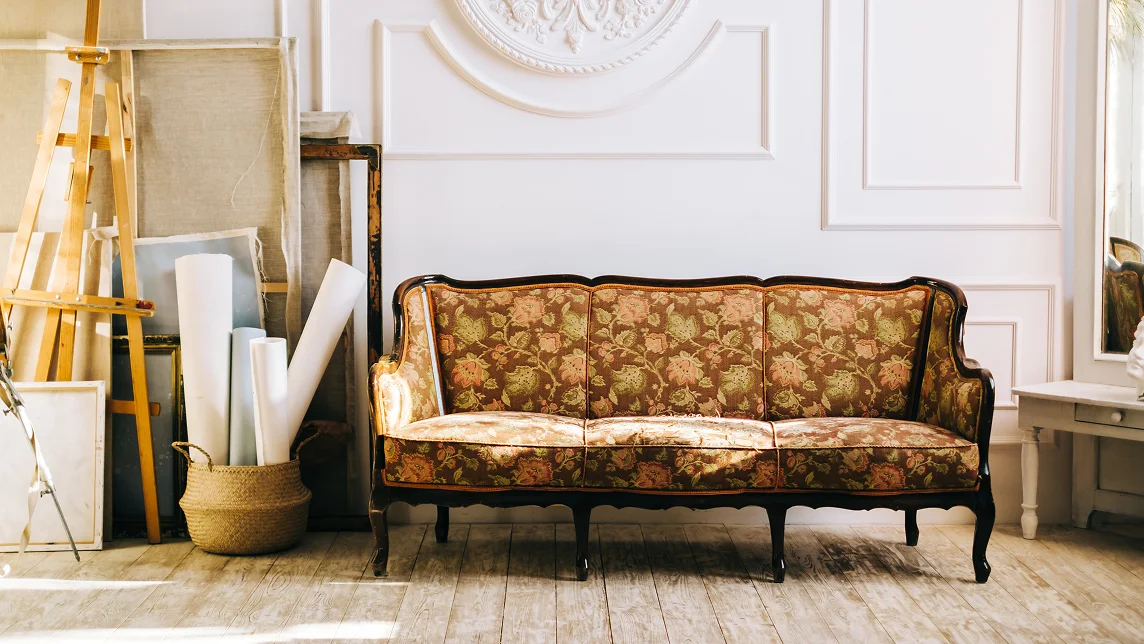Step into the world of rococo prints, country cottage vibes, and the romantic side of textile history.

Imagine sunlight spilling through a lace-curtained window, casting soft shadows across a room lined with floral wallpaper and chintz-upholstered chairs. The air feels still, save for the occasional rustle of fabric or the creak of a wooden floor beneath your feet. Every surface tells a story—through delicate embroidery, winding vines, pastoral scenes, and intricate lacework.

We’re delighted to present this four-part blog mini series, designed for our community of creators, to inspire your work and deepen your connection to the world of historic textile design. Together, we’ll explore the enduring elegance and expressive power of English and French textile traditions, and how they continue to influence contemporary design.
This is more than a decorative choice, it’s a language. A language of romance, refinement, and cultural identity woven into every repeat, flourish, and motif. For centuries, French and English textile traditions have shaped the way we express beauty in our interiors, our wardrobes, and even our dreams. From the whimsical narrative prints of Toile de Jouy (think, iconic Christian Dior) to the soft opulence of damask and lace, these designs carry an enduring emotional weight that modern minimalism simply can’t replicate.
This blog mini series explores how French and English textile styles such as Toile de Jouy, chintz, lace, and damask have not only shaped interior and fashion history but continue to inspire modern designers today. These motifs are more than historical artifacts; they are a source of continual reinvention, timeless patterns reimagined to suit contemporary tastes and formats.
With today’s textile design software, these traditional aesthetics live on, digitally rendered, recolored, layered, and refined to meet the demands of modern applications. Whether for apparel or home décor, designers now have the tools to blend historical depth with contemporary innovation, all while preserving the charm and story behind every thread.
In this article, we’ll journey through the rich legacies of French and English textiles, exploring how their patterns evolved, how they shaped culture, and how they continue to inspire a new generation of creators. Whether you’re captivated by the elegance of a lace trim.
Nestled in the quiet village of Jouy-en-Josas, just outside of Versailles, a revolution in printed textiles was quietly unfolding in the late 1700s. At its helm was Christophe-Philippe Oberkampf, a visionary entrepreneur of German descent who established the now-famous Toile de Jouy manufactory in 1760. What began as a small operation quickly became a hub of artistic and technological innovation, ultimately earning Oberkampf the title of Royal Manufacturer under King Louis XVI.
Toile de Jouy—literally “cloth from Jouy”—was unlike anything France had seen before. These printed cotton fabrics featured monochrome narrative scenes, most often rendered in a single color such as indigo, sepia, or crimson on a white or cream ground. The illustrations were detailed and evocative: pastoral vignettes of shepherds and maidens, mythological tales, allegories of love, scenes of leisure in the French countryside. In essence, each repeat was a miniature stage, telling a quiet story that invited contemplation and escapism.

The design process was intricate. Early Toiles were hand-block printed using woodblocks carved with extraordinary precision. Later, copperplate printing techniques allowed for even greater detail and scale. What made Toile so remarkable—beyond its aesthetic beauty—was its ability to bring art and storytelling into the domestic sphere. These fabrics adorned wallcoverings, bed linens, drapery, and upholstery, transforming ordinary interiors into lush, narrative environments.
Toile de Jouy quickly became a symbol of refined taste in Rococo and Neoclassical France. Favored by the aristocracy and later embraced by the rising bourgeoisie, its decorative appeal extended far beyond French borders. The blend of elegance, fantasy, and narrative structure made it a textile form of literature; something magic, and one you could live within.
Today, the influence of Toile persists. Not just in historical estates or curated museum collections, but in modern design work that seeks to merge old-world beauty with contemporary storytelling. With digital design tools, textile artists can now revive these narrative repeats with even more flexibility: recoloring scenes, layering motifs, and experimenting with scale in ways Oberkampf could only dream of. But at its heart, Toile remains what it has always been—a canvas for the imagination.
While France was crafting pastoral daydreams in Toile, Britain, and soon much of Europe, was falling under the spell of something even more vibrant: chintz. Originating in India and made with masterful craftsmanship by Indian artisans, chintz was a painted or printed cotton fabric that featured lush floral motifs, intricate vines, exotic birds, and naturalistic forms, all finished with a distinctive glazed sheen that gave the surface a rich, almost lacquered feel.
Chintz was revolutionary. In 17th-century Europe, textile printing was rudimentary compared to the sophisticated resist-dyeing and mordant techniques used in Indian production centers like Masulipatnam and Surat. These fabrics arrived through the ships of the Dutch and British East India Companies, and the response was electric. Chintz captured the European imagination with its vibrant colors, organic compositions, and unparalleled durability. It was soft, washable, and vivid—ideal for clothing, bed hangings, and upholstery in a world still dominated by wool and linen.
Its popularity grew so fast that it began to threaten domestic textile industries. In 1686, France banned the import of printed cottons, and Britain followed with a similar ban in 1720… though not because people disliked chintz. Quite the opposite. The ban was a desperate attempt to protect local weavers and dyers from the flood of Indian imports dominating the market.
Yet the allure of chintz was too strong to suppress. European manufacturers eventually sought to reverse-engineer the Indian techniques, and by the mid-18th century, mills in England (notably in Manchester) and France had developed their own methods for printing and glazing cotton. These adapted versions became a cornerstone of Western interior and fashion aesthetics. In Britain, chintz became particularly associated with country house décor—bed curtains, slipcovers, and wallpaper panels that exuded a lived-in luxury. In France, chintz patterns were often paired with gilded moldings and Louis XV furniture, softening ornate spaces with floral lightness.
The signature elements of chintz—its glossy finish, rhythmic repeats, and bouquet-like motifs—continue to influence everything from heritage fashion collections to maximalist home trends. Today, digital textile software enables designers to simulate that same glazed depth and precision, while also playing with nontraditional palettes and hybrid compositions. With a few clicks, a designer can render a 17th-century-inspired chintz for a modern silk scarf or a virtual upholstery swatch—bridging continents, centuries, and cultures in a single print.
As the desire for printed textiles surged across Europe, technology became the great enabler of accessibility and expansion. What began as a labor-intensive artisanal process—using carved woodblocks for each individual color—soon evolved into a more industrialized practice with the advent of copperplate printing and later roller printing in the late 18th and early 19th centuries.
Block printing, while capable of exquisite detail, was slow and required meticulous alignment for multicolor designs. Copperplate printing introduced finer lines and greater complexity, allowing for the lush storytelling found in Toile de Jouy. But it was roller printing—developed in the early 1780s—that truly democratized these once-exclusive designs. With engraved metal rollers continuously applying patterns onto fabric, production became faster, more affordable, and scalable for a broader audience.
This mechanical leap meant that the romantic scenes of French pastoral life and the exotic florals of Indian chintz could now appear not only in palaces and manors, but also in modest middle-class homes across Britain, France, and beyond. Designs that once traveled by ship now spread by press—paving the way for an early globalization of textile motifs.
Through this diffusion, motifs were transformed: Indian florals took on British restraint, French narratives were adapted for colonial homes, and regional printing houses began adding their own flair. It was the beginning of something new—a shared visual language that transcended borders and social classes, yet remained deeply rooted in the aesthetics of home, comfort, and cultural storytelling.
This legacy of pattern transmission—through technology, trade, and adaptation—sets the stage for our next chapter: how textiles became symbols of luxury, femininity, and emotion in the intimate spaces of Rococo and Victorian life.
From romantic prints to tactile luxury, the journey continues. In Part 2, we’ll explore how lace, damask, and brocade transformed interiors and fashion into rich expressions of elegance and emotion.
Make sure to follow us on social media so you don’t miss the next chapter in this fascinating and inspiring journey through textile history.